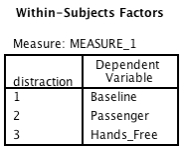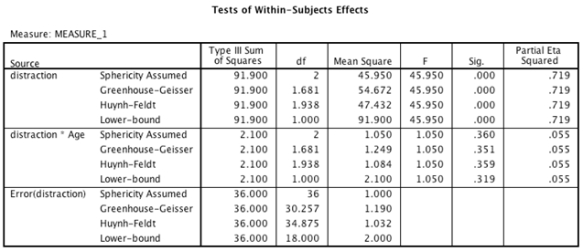An experiment was done to compare the effect of having a conversation via a hands-free mobile phone,having a conversation with an in-car passenger,and no distraction (baseline) on driving accuracy.Twenty participants from two different age groups (18-25 years and 26-40 years) took part.All participants in both age groups took part in all three conditions of the experiment (in counterbalanced order) ,and their driving accuracy was measured by a layperson who remained unaware of the experimental hypothesis. Which of the following sentences regarding the results of the simple contrasts of the distraction variable is correct? 


Definitions:
Generalizability
The extent to which the findings of a study or experiment can be applied to larger populations or different contexts beyond the original subjects or conditions studied.
Validity
The extent to which a test, measurement, or research accurately reflects or assesses the specific concept that it is intended to measure.
Constructability
A project management technique that reviews construction processes from start to finish during pre-construction phase to ensure efficient and feasible construction.
Predictive Validity
The extent to which a score on a scale or test predicts future performance on a related outcome.
Q1: Your CEO has followed your advice and
Q2: What is the different between these two
Q8: A study undertaken in a surgical ward
Q9: Which of the following is an example
Q13: Which of the following assumptions are relevant
Q14: What happens when there is a systematic
Q15: Which of the following techniques is a
Q18: Factors determined from correlation with other variables
Q18: A health researcher was interested in the
Q19: A teacher asks a class of students